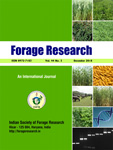RAKESH KUMAR, HARDEV RAM*, PRAVEEN B. R., CHETHAN BABU R. T., SUPRIYA AND BHARTI DEVI
ICAR-National Dairy Research Institute, Karnal-132 001 (Haryana), India
Tea Research Association, North Bengal Regional R & D Centre, Nagrakata, Jalpaiguri-735 225 (West Bengal), India
Teaching Associate, Department of Agronomy, S. V. Agricultural College, Tirupati-517502, India 3G.S.G.D Girls Agriculture College, Padampur-335041, India
*(e-mail: devagron@gmail.com)
(Received: 2 September 2024; Accepted: 25 September 2024)
SUMMARY
A field experiment was conducted during kharif season of 2019-20 at Research Farm, Agronomy Section, ICAR-National Dairy Research Institute, Karnal (Haryana). The experiment was laid out in Randomized Complete Block Design with eight treatments, i.e., T1 (Absolute control); T2 (100% RDF); T3 (100% RDF + Cow urine foliar spray); T4 (100% RDF + PGPR); T5 (100% RDF + PGPR + Cow urine foliar spray); T6 (75% RDF + Cow urine foliar spray); T7 (75% RDF + PGPR) and T8 (75% RDF + PGPR + Cow urine foliar spray) with three replications. Study indicated that the growth and yield parameters of fodder pearl millet significantly affected with different nutrient management practices and found plant height (178.3 and 307.5 cm), leaf length (86.5 and 110.4 cm), no. of leaves/ plant (11.4 and 15.3), no. of tillers/plant (11.3 and 13.1), leaf width (4.3 and 5.1 cm) and stem girth (2.2 and 3.7 cm) at 40 DAS and harvest respectively, while, yield of green (54.58 t/ha) and dry fodder yield (11.17 t/ha) at harvest significantly increase up to application of 100% RDF+PGPR and they further increase with application of 100% RDF+PGPR+CU, but doesn’t reach up to significance level over 100% RDF+PGPR. However, both were remains statistically at par to each and found significantly higher than other treatments. Maximum net return was recorded with T4 followed by T5, T2 and T7 treatment. However, maximum B:C ratio was found with T4, followed by T7 and T5 treatments. Which, will further strengthen and sustain crop productivity and profitability.
Key words: Cow urine, Fodder, Growth, Pearl millet, Yield

